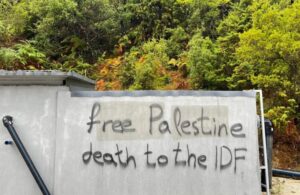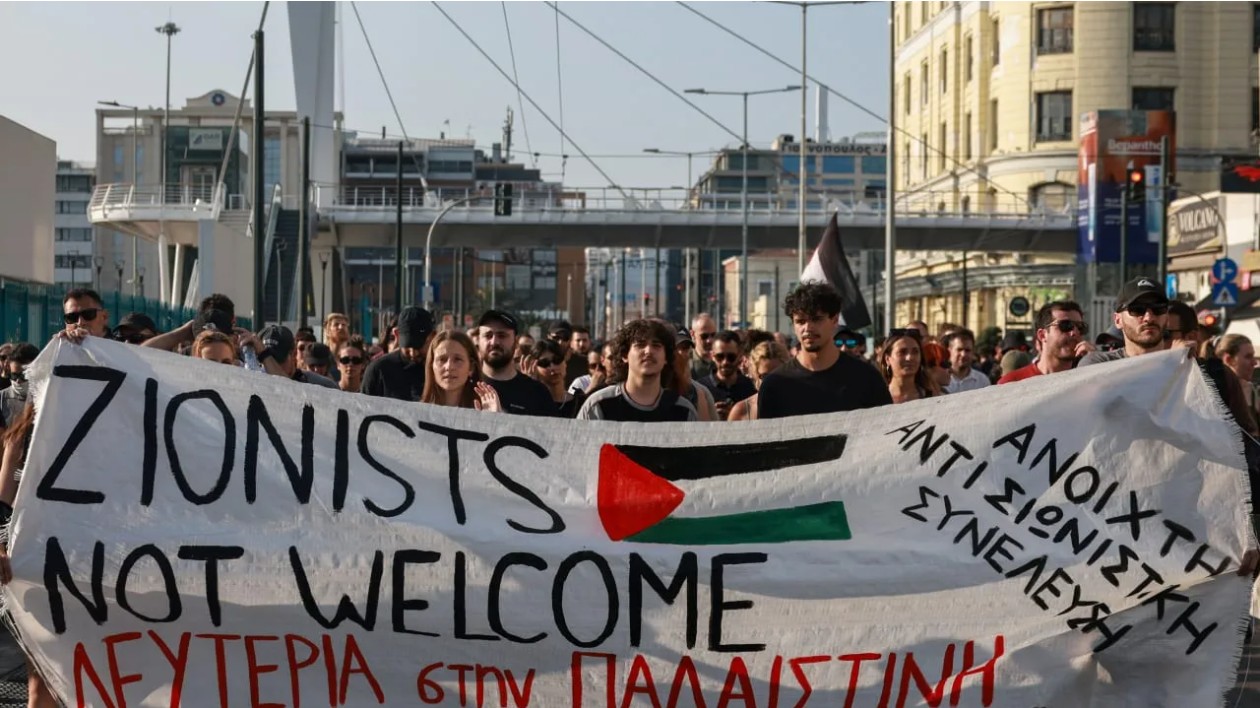This is not just a Jewish problem. The time is now to urge people, especially non-Jews, to speak up before it’s too late.
Antisemitism is no longer simmering beneath the surface. It’s erupting in schools, universities, city streets, corporate offices, and even in the halls of government. Jews are being attacked simply for being Jews, and the world is watching with the same passivity it did in the 1930s.
In just recent days, disturbing reports have surfaced from the West, exposing an escalation in brazen and violent antisemitic attacks. Take Nassau County, New York, where a woman was arrested for tearing down an Israeli flag, a simple symbol turned into a target of hatred. Meanwhile, in White Plains, New York, red spray-painted graffiti reading “F*** Israel” greeted residents on their very own sidewalks.
Passengers on flights are greeted with food packets with handwritten words of “Jew Hatred.”
In Poland a Jewish man was physically attacked for no reason in front of his daughter. In St. Louis, the hatred took a darker turn, as antisemitic slurs directed at a recently returned American-Israeli soldier were scrawled outside his home, followed by the torching of three cars.
There is also clear documentation of record-high hate crimes against Jews as well as rising antisemitism across Europe and violent rhetoric spreading across social media. These incidents are not isolated blips; they are part of a growing pattern that’s hard to ignore.

Antisemitic slurs in Tzoumerka, Greece (credit: Dafna Yarom)
Latest statistics on antisemitism
Random acts of antisemitism have always lurked beneath the surface, but the FBI’s latest report confirms something more alarming: The Jewish community remains the most targeted religious group in hate crimes across the United States in 2024. The number of people taking to the streets against Israel in Australia, England, Greece, and elsewhere is a grim reflection of a social shift that not only feels darker but is also more threatening than previously.
Not only is this war against Jews being funded and perpetuated by Islamists, but there are also Jewish influencers who appear on social media and television shows framing Israel as an aggressor. Take, for example, Peter Beinart who compares the location of Israel’s defense establishment headquarters in Tel Aviv with the fact that Hamas uses hospitals and schools as launching zones for rockets.
What’s truly chilling, though, is how these attacks have evolved. They’re no longer confined to vandalism or violence in physical spaces. Today, antisemitism takes on new, insidious forms, such as online harassment, coordinated disinformation, and doxing. The practice of doxing – publishing private, identifying information about individuals online – is weaponized to intimidate, to terrify, and to endanger not just individuals but entire families. It’s a digital mob tactic with real-world consequences.
The most disturbing example emerged last week from Press TV, an Iranian state-run media outlet. In an article titled “Meet the Zionist ‘charity’ that has brought over 5,000 Israeli war criminals to Britain,” the outlet branded those who provide aid to wounded Israeli soldiers as war criminals. The article went further, naming nine individuals and listing their homes and workplaces.
While a good deal of this information can be obtained via online searches, the fact that it is published in an alleged news source is beyond civility. This isn’t just reckless journalism; it’s a calculated act of targeting and turning people into marked victims. The message is clear: These individuals are not just criticized; they are threatened. And this threat extends far beyond those named, casting a shadow over Jewish communities worldwide.
An echo of dark chapters in history
This shift is a stark reminder that the post-World War II veil of civility that the West draped over antisemitism has been torn away. The fragile sense of progress that followed the Holocaust, where baseless hatred against Jews was forced underground, has given way to open hostility.
Jews are once again the classic target, while perpetrators of violence like Hamas have managed to cloak themselves in a twisted narrative that blames the victims rather than the aggressors. The world is once again in “apathy” mode; few reflect on the eerie silence or outright justification of Jew-hatred from progressive, academic, and even political circles.
It’s no coincidence that Heil Hitler salutes have appeared at pro-Palestinian rallies, echoing the darkest chapters of history. Hamas’s war extends beyond Israel’s borders, striking at Jews worldwide. The failure to call out this reality fuels the flames of hatred and violence. The world risks losing sight of the truth in a muddled sea of misinformation.
Clear lines can be drawn from the 1930s to now: scapegoating, conspiracy theories, global instability, economic anxiety, and blaming the Jews. And the generations under 40 years old tend to lack knowledge of history, let alone the Holocaust, making them at best apathetic and at worst useful idiots.
We are witnessing a dangerous shift. Hatred is no longer whispered in shadows or confined to the margins. It’s shouted from rooftops, painted on sidewalks, and broadcast online for all to see. This is a new era where antisemitism is both physical and digital, personal and public, old and yet disturbingly new.
If we don’t confront this openly and honestly, Israel will win the battle against Hamas, but the war against antisemitism will be lost, and those in the Diaspora will be targeted. The shadows of the past, long thought to be fading, will stretch even longer across our present, and that’s a future none of us can or should accept.
Ultimately this is not just a Jewish problem; it’s a measure of whether societies will defend liberal democracies and human dignity at all. The time is now to urge people, especially non-Jews, to speak up before it’s too late.
Dr. Michael J. Salamon is a psychologist specializing in trauma and abuse and director of ADC Psychological Services in Netanya and Hewlett, NY. Louis Libin is an expert in military strategies, wireless innovation, emergency communications, and cybersecurity.
